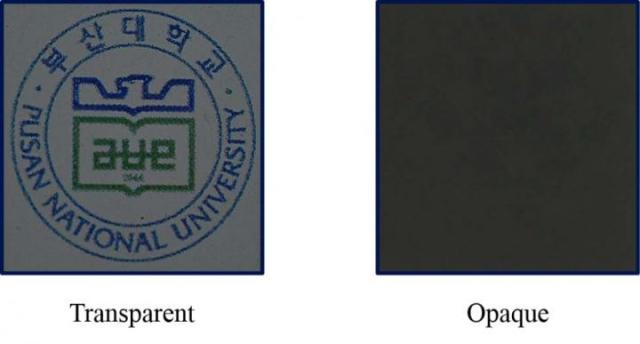Apr 29 2015
A research team at Pusan National University in South Korea has developed transparent light shutters using a new liquid crystal technology. This technology enables displays to switch between opaque and transparent states, thereby hypothetically enabling a viewer to switch their view within a millisecond.
 A dye-doped PNLC cell in the transparent and opaque states, placed on a printed sheet of paper. In the transparent state, the clear background image can be seen because of the high transmittance of this cell. In the opaque state, black color is provided and the background image is completely blocked, because the incident light is simultaneously scattered and absorbed. (Credit - T.-H.Yoon/Pusan Natl Univ)
A dye-doped PNLC cell in the transparent and opaque states, placed on a printed sheet of paper. In the transparent state, the clear background image can be seen because of the high transmittance of this cell. In the opaque state, black color is provided and the background image is completely blocked, because the incident light is simultaneously scattered and absorbed. (Credit - T.-H.Yoon/Pusan Natl Univ)
Although the concept of producing transparent displays has been proposed few years ago, the actual means of producing the displays using conventional organic LEDs has proved to be complex.
"The transparent part is continuously open to the background. As a result, they exhibit poor visibility," said Tae-Hoon Yoon, the group's primary investigator.
Light shutters making use of liquid crystals, which can be swapped between transparent and opaque states upon absorption or scattering of incoming light, can be used to resolve this issue. However, it should be noted that the shutters have their own disadvantages.
The light shutters based on scattering do increase the visibility of the displays, but they do not produce black color, while the shutters based on absorption are unable to block the background completely. These shutters require continuous power supply to maintain their transparent 'window' state in non-operating conditions, meaning they are not especially energy-efficient. In addition, they are also limitied in their power on and off response times.
The new model developed by the Tae-Hoon Yoon's group, however, overcomes all the limitations of these shutters by simultaneously using both scattering and absorption. In order to achieve this, the researchers doped fabricated polymer-networked liquid crystals cells with dichroic dyes.
The polymer network structure of the new model scatters incident light absorbed by the dichroic dyes. The light shutters are made up of electrodes arranged in parallel, one above and below the vertically aligned liquid crystals. With the application of an electric field over the electrodes, the dye molecule axes are aligned with respect to incoming light. This enables them to absorb and scatter light, effectively negating the light incident on the screen from behind. As a result, an opaque display is rendered, allowing full visibility of the screen’s images.
"The incident light is absorbed, but we can still see through the background with reduced light intensity," Yoon said.
This setup allows the light to pass through when in its resting state. Therefore, power is required only while switching the transparent window view to an opaque monitor view. As the on-off switch of the display is an electric field, the response time is not even one millisecond, which is faster than the conventional light shutters that require their liquid crystals to relax slowly as their off-switch.
The research group is further working on respectively improving and suppressing the transmittance of the device at the transparent and opaque states. In addition, the team is trying to develop a bi-stable light shutter that requires power only while switching the states.